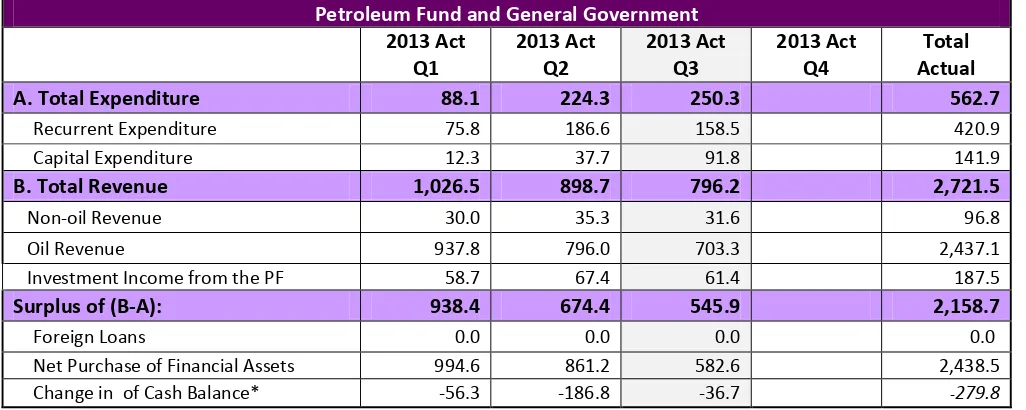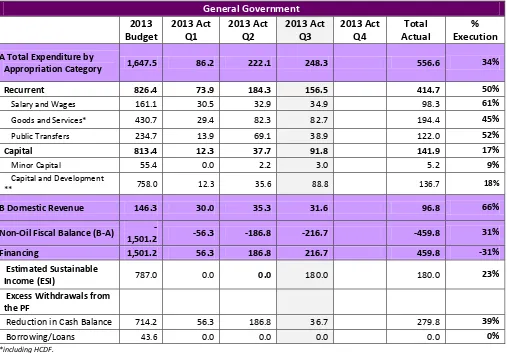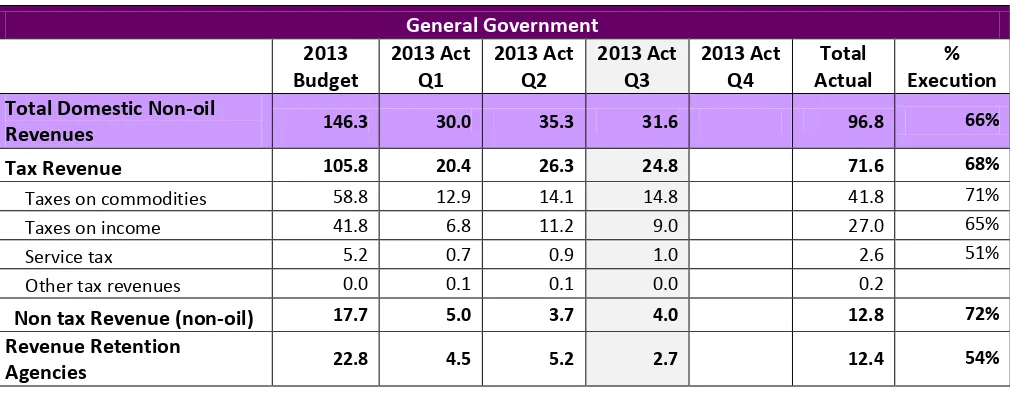GFS - Vol. 4
GFS - Vol. 4
Executive Summary
In the first three quarters of 2013, the General Government of Timor Leste (GGoTL) including the Petroleum Fund (PF) is running a surplus of $2,158.7 million. Overall this means that the GGoTL is able to sustain its current level of operations.
Excluding the PF, the GGoTL is running a non-oil deficit of $459.8 million. Higher and increasing recurrent expenditures and a low execution capacity in the Infrastructure Fund are trends which have continued in 2013.
Overall fiscal position (Oil and Non-oil)
By the 30th September 2013, the GGoTL, including PF has a surplus of $2,158.7 million.
Table 1. Overall Fiscal Position
Petroleum Fund and General Government
*In this table a minus number shows a reduction in the amount of cash the Government holds in its accounts.
By the 30th September 2013 total expenditures reach $562.7 million. Expenditure is driven mostly by recurrent expenditure which totals $420.9million. Capital expenditure is much more modest, totaling $141.9 million. Total revenue stands at $2,721.5 million, driven mostly by revenues in the PF which total $2,624.6 million. PF revenues comprise of PF gross receipts (including taxes, royalties and first tranche petroleum) and investment income (including dividends, interests and trust income, but excluding fair value gains and losses on profit/loss)1.
1
The reason for excluding gains and losses on profit/loss and on exchange rates is due to these items being accrued but not
GFS - Vol. 4
cashed. including the Petroleum Fund (PF) is running a surplus of $2,158.7 million. Overall this means that the GGoTL is able to sustain its current level of operations.Excluding the PF, the GGoTL is running a non-oil deficit of $459.8 million. Higher and increasing recurrent expenditures and a low execution capacity in the Infrastructure Fund are trends which have continued in 2013.
Ministry of Finance Economic Policy Directorate
Fiscal Bulletin Q3 Page 2
Overall fiscal position (Oil and Non-oil)
By the 30th September 2013, the GGoTL, including PF has a surplus of $2,158.7 million.
Table 1. Overall Fiscal Position
Petroleum Fund and General Government
*In this table a minus number shows a reduction in the amount of cash the Government holds in its accounts.
By the 30th September 2013 total expenditures reach $562.7 million. Expenditure is driven mostly by recurrent expenditure which totals $420.9million. Capital expenditure is much more modest, totaling $141.9 million. Total revenue stands at $2,721.5 million, driven mostly by revenues in the PF which total $2,624.6 million. PF revenues comprise of PF gross receipts (including taxes, royalties and first tranche petroleum) and investment income (including dividends, interests and trust income, but excluding fair value gains and losses on profit/loss)2.
The overall surplus (total revenue – total expenditure) is $2,158.7 million. This shows that the Government is, including the Petroleum Fund, in a strong financial position and has a surplus which can be invested in financial assets.
Total purchase of financial assets is $2,438.5 million at the end of the third quarter 2013. Total expenditure and the purchase of financial assets combined were larger than total revenues throughout the year and therefore
the a ou t of ash held i the Gove e t’s a ou ts de eased y $2 . illio ove the th ee ua te s u til
The overall surplus (total revenue – total expenditure) is $2,158.7 million. This shows that the Government is, including the Petroleum Fund, in a strong financial position and has a surplus which can be invested in financial assets.
Total purchase of financial assets is $2,438.5 million at the end of the third quarter 2013. Total expenditure and the purchase of financial assets combined were larger than total revenues throughout the year and therefore
the a ou t of ash held i the Gove e t’s a ou ts de eased y $2 . million over the three quarters until
the 30th of September 2013. However this reduction in cash does not represent a reduction in the overall financial position of the GGoTL, as it is outweighed by the increase in the purchase of financial assets.
2
Fiscal Bulletin Q3 Page 3
Ge eral Gover
e t’s Fiscal Position
Table 2. Non-Oil Fiscal Position
Excess Withdrawals from
the PF
Reduction in Cash Balance 714.2 56.3 186.8 36.7 279.8 39%
Borrowing/Loans 43.6 0.0 0.0 0.0 0.0 0%
*including HCDF.
**including Infrastructure exp.
At the end of the third quarter 2013, the GGoTL has accumulated a non-oil deficit of $459.8 million, as seen in Table 2. Total expenditures in the GGoTL are financed through a combination of withdrawals from the PF, a reduction in the cash balance and loans. By the end of the third quarter of 2013 $180 million had been withdrawn from the PF and $279.8 million had been used from the cash balance, as no money was disbursed on loans.
Fiscal Bulletin Q3 Page 4 2013. This is 10% lower than the $456.6 million recorded in the same period in 2012. Capital expenditures reduced 58% (from $335 million to $141.9 million) across the same period in 2012 and 2013.
Recurrent expenditures are divided into:
Salary and Wages comprises the smallest group of expenditures, totaling $98.3 million during the first three quarters of 2013 and 12% higher than the $ 87.7 million incurred in the first three quarters of 2012. This represents 61% of the total budgeted for the year.
Goods and Services is the largest category of recurrent expenditures, totaling $194.4 million throughout the first three quarters in 2013 and with an execution rate of 45%. This represents a 14% reduction compared to the $225.6 million incurred in the same period of 2012. This reduction was strongly affected by lower spending on fuel for generators. Within Goods and Services, expenditures on human capital through the HCDF have also reduced 57% compared to last year, reaching $10.5 million by the 30th September 2013.
Public Transfers total $122.0 million by the end of the third quarter of 2013, 15% lower than the $143.30 million paid out in the same quarter of 2012 and represents 52% of budgeted expenditure on public transfers for 2013. The reduction is explained by a fall in the Ministry of Social Solidarity’s transfers in 2013 compared to 2012, partly due to the unexpected natural disasters which occurred in 2012 and which required more emergency funds last year.
Capital expenditures total $141.9 million by the 30th September 2013. This is 58% lower than the $345 million spent in the third quarter of 2012 and represents 17% of the annual budgeted capital expenditure.
Capital expenditures are composed of:
Minor Capital reaches $5.2 million at the end of the third quarter of 2013, 73% lower than the $19.2 million spent in the same quarter of 2012.
Fiscal Bulletin Q3 Page 5
Total domestic, non-oil revenues at the end of third quarter of 2013 reaches $96.8 million. This means that by the 30th September 2013, the total execution rate for non-oil revenue collection is only 66% of the amount budgeted for the year. By the 30th September 2013, 74% of total revenue is tax revenue, whereas the remaining 26% is collected from a combination of non-oil non tax revenue and from Retention Agencies.
Tax Revenue is divided into:
Taxes on commodities are the largest tax revenue category, totaling $41.8 million at the end of the third quarter of 2013. This is 8% higher than the $38.8 million collected for the same period of 2012. This increase stems from an increase in excise tax collected, counteracted by a reduction in the collection of sales tax and import duties.
Taxes on income are the second largest category totaling $27.0 at the end of the third quarter of 2013, 5% lower than the 28.6 million collected by the 30th September of 2012. By 30th September 2013, taxes on income are 65% of the total annual budgeted, lower than collection of taxes on commodities.
Service tax has decreased by 20% compared to the first three quarter of 2012, totaling $2.6 million by the end of the third quarter of 2013. This category represented the lowest execution rates, amounting to 51% of annual budgeted taxation rates.
Other Tax Revenues reach $0.2 million, much higher than the $0.04 million collected in the same period of 2012.
Fiscal Bulletin Q3 Page 6 Finally, the Revenue Retention Agencies collected $12.4 million by the end of the third quarter of 2013, 12% lower than the $14 million collected in the same period of 2012. The reduction is due to a strong reduction in electricity fees and charges. This represents 54% of the forecast in the annual budget.
Financing
As seen in Table 2, all non-oil expenditures incurred by the GGoTL are financed through a combination of withdrawals from the PF, loans and use of the cash balance. However, due to the large rollover from 2012, the GGoTL has prioritized making use of the cash balance instead of PF withdrawals to finance non-oil deficits in 2013.


